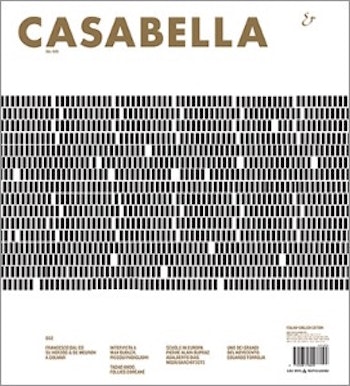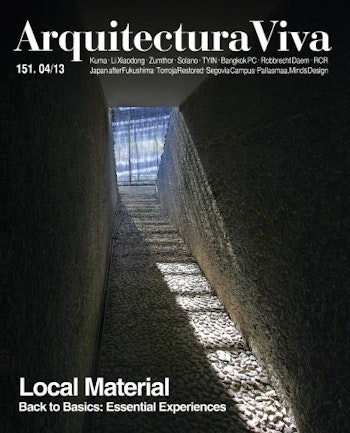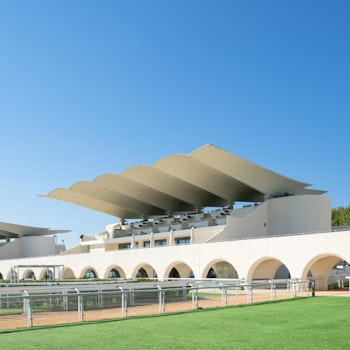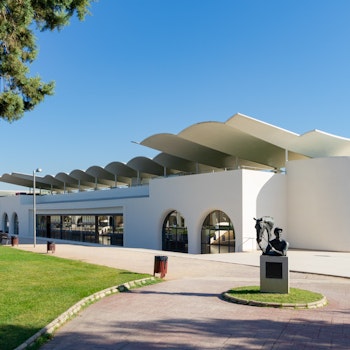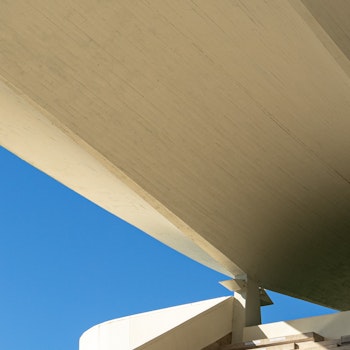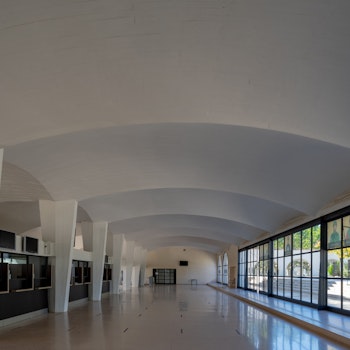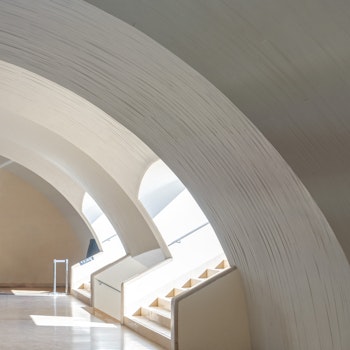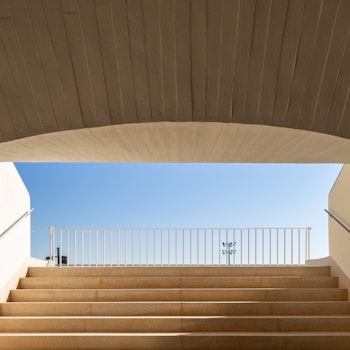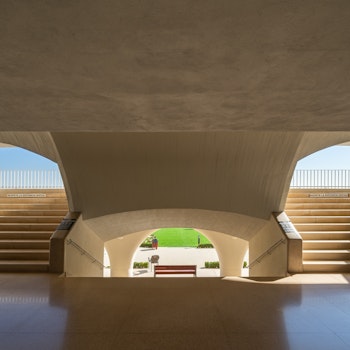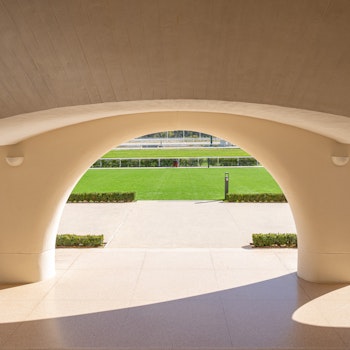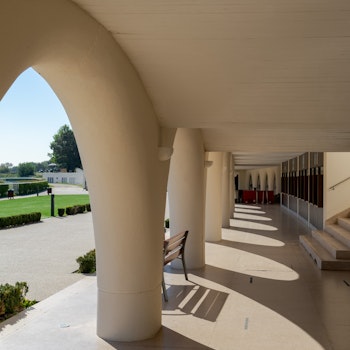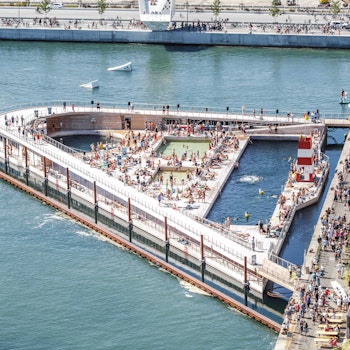ARCHITECT
JUNQUERA ARQUITECTOS
PUBLICATIONS Arquitectura Viva, Casabella
Located in the outskirts of Madrid ,the Hipódromo de la Zarzuela (the Zarzuela racecourse), is considered one of the most outstanding works of Spanish modern architecture from the first third of the 20th century, As winning proposal from a competition set out for its construction in 1934, the project of Hipódromo de la Zarzuela was drawn out in 1935 by the two Spanish Modern Movement architects Carlos Arniches (1895–1958) and Martín Domínguez (1897–1971), together with the renowned structural engineer Eduardo Torroja (1899–1961). The construction started the year after, however damages during the Spanish Civil War delayed the completion, being it only inaugurated in 1941.
Considered as a perfect functional combination between the extend programmatic organization requirements of a racecourse and the architectural design of the tribune’s roof with the minimum possible material, Hipódromo de la Zarzuela’s original structure is characterized by boldly cantilevered, vaulted canopies consisting of reinforced concrete elements – some of them only 6 centimeter thick – jutting out above the tiered seating, while the base is composed of arches that are more traditional.i But the cantilevered roof covered not only all three tribunes, it functioned as well as a “counterweight bridge” of more than 12 meters span of light, responding herewith to the necessarily special adaptation of the dependencies located under the stands. It is considered therefore as a avant-garde exponent of technological research on new construction materials and techniques. Furthermore, its design enhanced the integration of the complex into the landscape of Monte de El Pardo, at a time when the La Coruña highway did not yet exist.ii Thus, due to its structure, Hipódromo de la Zarzuela is considered one of the great achievements of the century, namely as part of the racionalismo madrileño, and is one of the last, if not the last, architectural masterpiece of the Spanish Republic time. iii
As the company operating the racecourse underwent bankrupt procedures in 1996, Hipódromo de la Zarzuela started deteriorating over time due to lack of maintenance. Specially affected were the canopies, as they were not only deteriorated, but presented also several damages due to water infiltrations and various constructions carried out in previous stages.
Historic and artistic monument since 1980, the Spanish Ministry of Culture declared the Zarzuela racecourse complex to be a monument of cultural interest in 2009, referring that “it represented in its time and still nowadays an important advance both from a structural point of view and regarding the type of materials used in its construction.” iv
For its renovation an international competition was organized in 2003, having been the renovation proposal by Junquera Arquitectos selected. The project was then worked out the following years until 2008.
The renovation of the building was based on two fundamental premises: research into the historical evolution of the Zarzuela racecourse; and a quest for a balance between the building’s core identity and the new requirements demanded by its use.
The first premise – research into the historical evolution of the racecourse – was adopted in order to rescue and rebuild the core values of the 1935 design. This was a difficult task, since the project was only completed in the aftermath of the Civil War, without the presence of its architects, and no reference documents from this period had survived (except for the structural engineering drawings). Nonetheless, the research was undertaken using the original plans from the 1934 competition and in situ surveys. They revealed not only modifications and extensions to the original design, but also significant structural damage, requiring consolidation and repair work.
The second premise – the quest for a balance between the building’s identity and contemporary requirements – was adopted in order to secure the building’s longevity, as only through its continuous use could be best guaranteed its preservation.
Thus, it was possible to define a renovation project capable of recovering and upgrading the original character of the building. The renovation comprised therefore mainly: the removal of the disfiguring changes that had occurred over time; the restoration of the stands’ structure; the adaptation of the topography and circulation of both the public and horses as laid out in the 1934 project, namely the public accesses the enclosure through the patios, which are connected in the paddock gallery, being able to follow from here all the horses’ movements on the lower level without interfering with each other; keeping the original position of the stables, concentrating other racing, jockey and veterinary services in a new building dug into the ground and open to the gardens (providing privacy, natural lighting and ventilation) and with independent accesses and direct connection to the paddock and the central grandstand without crossing paths with the visitors areas; and anticipating the possible expansion of an underground convention center in the north yard, without affecting views of the historic buildings and landscape.
Starting with the restoration of the canopies of the tribunes, in 2008, the renovation works lasted until 2015. In parallel to the restoration of the canopies, constructive prospecting works were carried out to discover and analyze the values and original construction systems, distorted and lost due to extensions and modifications carried out in the rececourse. Unfortunately, these made evident that existed significant structural damages thus, being required consolidation and repair works of the structure. Once these works were finished, started the restoration and rehabilitation of the architectural complex, with the aim of recovering the essential values of the original project.
In summary, the renovation project aimed to reclaim the Zarzuela racecourse for the city as an optimum facility for racing and equestrian sport, balanced with the use and enjoyment of the monument.
i Ignasi de Solà-Morales, Antón Capitel, Peter Buchanan, et al., Birkhäuser Architectural Guide Spain 1920-1999, Basel, Birkhäuser, 1998, p. 239
ii Boletín Oficial del Estado, No. 266, 4 November 2009, sec. III, 92342; “El hipódromo de la Zarzuela, monumento histórico-artístico”, El Pais, 25 November 1980.
iii El País, op.cit.
iv Boletín Oficial del Estado, op. cit., 92342.
source: Junquera Arquitectos
YOU MAY ALSO LIKE

